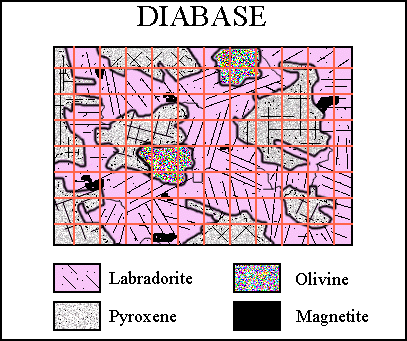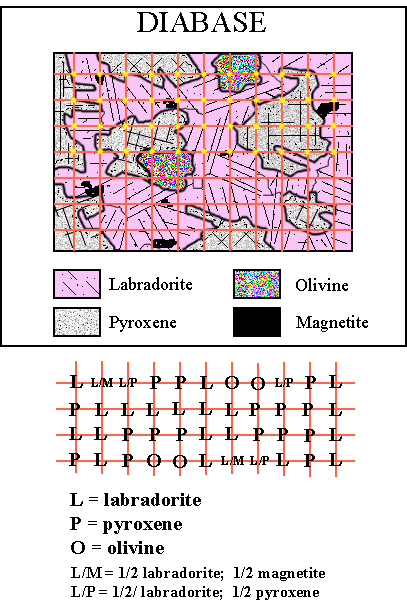|
One common way in which geologists quantitatively determine the mineral composition of a rock is to examine very thin slices of the rock called 'thin sections'. The thin sections are examined using a 'petrographic microscope', which permits viewing under ordinary and under polarized light. In this exercise, you will examine a drawing of a thin section of the rock diabase and determine its mineral composition. Follow these steps:
-
Click on the pink button marked 'P' and print out a copy of the 'Mineral Tally Sheet' (printout #Q-1B).

- Examine the microscope drawing of the rock diabase shown on the right. The rock is composed of the four minerals indicated in the legend. A rectangular grid has been superimposed over the diabase. The grid has 7 horizontal lines and 11 vertical lines, creating 77 intersections.
- Look at each of the 77 intersections in turn. For each, identify the mineral or minerals that directly underlie the intersection.
- Do not confuse the 77 grid intersections with the 96 square boxes created by the grid. You are to identify the material under the intersections, not within the square boxes!
- If only one mineral underlies the intersection, put a pencil stroke in the row of the appropriate mineral in the tally sheet. If the intersection lies over the contact between two different minerals, add a half stroke in each of the two appropriate mineral rows in the tally sheet.
The top four rows have been done for you. Examine the drawing on the right. The mineral or minerals underlying the yellow dots are identified by letters in the partial grid shown beneath the drawing. In the top four rows there are 21.5 labradorite, 17.5 pyroxene, 4 olivine and 1 magnetite, for a total of 44 intersections.
- Count the number of strokes in each mineral row in the tally sheet and enter the sum in the "TOTAL" box near the end of the row. (Don't forget to put strokes or half strokes for the minerals identified for you in the top four rows.)
- Add together all the totals in the TOTAL column and enter the result in the GRAND TOTAL box. (Note that the 'grand total' should equal the number of intersections, in this case 77.)
- Convert each TOTAL into a percentage by dividing the TOTAL by the GRAND TOTAL and then multiplying the result by 100. Round off the percentages to one decimal place.
- Enter these percentages in the '%' column.
- To check your results, click on the blue button to go to the Answer Checking Table.

- Enter the results in the 'diabase' column in the Mineral Composition Tabulation Sheet (printout #Q-1A).
- Percentages of minerals in other NYC materials have been calculated for you and are given in the Geologic Materials Table.
 How do you think the accuracy of this method of determining rock mineralogy might be improved? How do you think the accuracy of this method of determining rock mineralogy might be improved?
|
 |
 How do you think the accuracy of this method of determining rock mineralogy might be improved?
How do you think the accuracy of this method of determining rock mineralogy might be improved?


